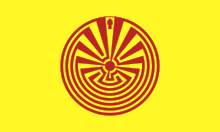- I'itoi
-
Iʼitoi or Iʼithi is, in the tradition of the O'odham people, the mischievous creator god who resides in a cave just below the peak of Baboquivari Mountain, part of the Tohono O'odham Nation. Visitors to the cave are asked to bring a gift to ensure their safe return from the depths. I'itoi is said to have brought the Hohokam people to this earth from the underworld, said to be ancestors of both the Tohono O'odham and the Pima. He is also responsible for the gift of the Himdag, a series of commandments guiding people to remain in balance with the world and interact with it as intended.
The Pima also refer to I'itoi as Se:he (Elder Brother). The term Iʼithi is a dialectal variant used by the Hia C-ed O'Odham.
He is most often referred to as the Man in the Maze, a reference to a design appearing on native basketry and petroglyphs which positions him at the entry to a labyrinth. This labyrinth is believed by the Pima to be a floorplan of his house, and by the Tohono O'odham to be a map giving directions to his house.
Contents
Modern appearance
The Man in the Maze motif is used liberally in the American Southwest, most prominently by Tohono O'odham silversmiths in rings and jewelry to showcase the quality of their technique and by Pima basketweavers, with whom it has been a very popular pattern since the 1900s. Every basket pattern has a "mistake" (also known as a "dau", or door) intentionally integrated into its design so that the spirit of the basket can be released.
Legend
According to O'odham oral history, the labyrinth design depicts experiences and choices we make in our journey through life. In the middle of the "maze", a person finds their dreams and goals. When one reaches the center, we have one final opportunity (the last turn in the design) to look back upon our choices and path, before the Sun God greets us, blesses us and passes us into the next world.
Oral History
as told by Alfretta Antone
"Elder Brother lived in the maze ... and the reason why he lived in the maze was because ... I think how I'm gonna say this ... magician or oh, medicine man that can disappear, and that can do things, heal people and things like that ... that was Elder Brother ... Se:he ... they called him ... he lived in there ... but he had a lot of enemies so he made that, and to live in there people would go in there but they couldn't find him ... they would turn around and go back.
"But in real life ... when you look at the maze you start from the top and go into the maze ... your life, you go down and then you reach a place where you have to turn around ... maybe in your own life you fall, something happens in your home, you are sad, you pick yourself up and you go on through the maze ... you go on and on and on ... so many places in there you might ... maybe your child died ... or maybe somebody died, or you stop, you fall and you feel bad ... you get up, turn around and go again ... when you reach that middle of the maze ... that's when you see the Sun God and the Sun God blesses you and say you have made it ... that's where you die.
"The maze is a symbol of life ... happiness, sadness ... and you reach your goal ... there's a dream there, and you reach that dream when you get to the middle of the maze ... that's how I was told, my grandparents told me that's how the maze is."
References
- The Salt River Pima-Maricopa Indians by Dr. John Myers and Dr. Robert Gryder. Published by Life's Reflections, Inc., 1988.
Categories:- Mythology of the indigenous peoples of North America
- Tohono O'odham
Wikimedia Foundation. 2010.

